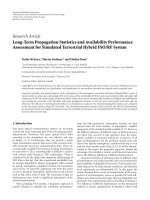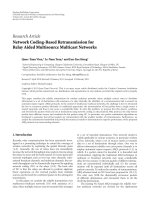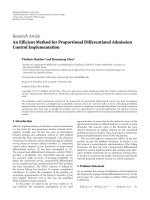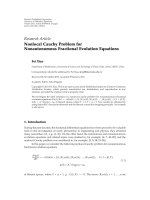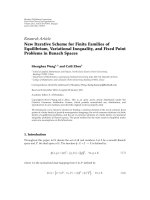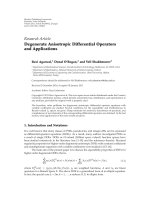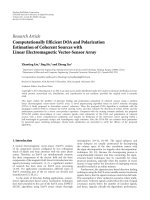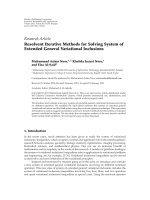Báo cáo hóa học: " Research Article Results on the Existence and Convergence of Best Proximity Points" pot
Bạn đang xem bản rút gọn của tài liệu. Xem và tải ngay bản đầy đủ của tài liệu tại đây (488.36 KB, 10 trang )
Hindawi Publishing Corporation
Fixed Point Theory and Applications
Volume 2010, Article ID 386037, 10 pages
doi:10.1155/2010/386037
Research Article
Results on the Existence and Convergence of
Best Proximity Points
Ali Abkar and Moosa Gabeleh
Department of Mathematics, Imam Khomeini International University, P.O. Box 288, Qazvin 34149, Iran
Correspondence should be addressed to Moosa Gabeleh,
Received 24 February 2010; Accepted 10 June 2010
Academic Editor: W. A. Kirk
Copyright q 2010 A. Abkar and M. Gabeleh. This is an open access article distributed under
the Creative Commons Attribution License, which permits unrestricted use, distribution, and
reproduction in any medium, provided the original work is properly cited.
We first consider a cyclic ϕ-contraction map on a reflexive Banach space X and provide a positive
answer to a question raised by Al-Thagafi and Shahzad on the existence of best proximity points
for cyclic ϕ-contraction maps in reflexive Banach spaces in one of their works 2009. In the second
part of the paper, we will discuss the existence of best proximity points in the framework of more
general metric spaces. We obtain some new results on the existence of best proximity points in
hyperconvex metric spaces as well as in ultrametric spaces.
1. Introduction
Let X X, d be a metric space, and let A, B be two subsets of X. A mapping T : A ∪ B →
A ∪ B is said to be cyclic provided that TA ⊆ B and TB ⊆ A.In1 Kirk et al. proved the
following interesting extension of the Banach contraction principle:
Theorem 1.1 see 1. Let A and B be two nonempty closed subsets of a complete metric space X.
Suppose that T is a cyclic map such that
d
Tx,Ty
≤ αd
x, y
1.1
for some α ∈ 0, 1 and for all x ∈ A, y ∈ B.ThenT has a unique fixed point in A ∩ B.
Later on, Eldred and Veeramani 2 considered the class of cyclic contractions.
2 Fixed Point Theory and Applications
Definition 1.2 see 2.LetA and B be two nonempty subsets of a metric space X,andlet
T : A ∪ B → A ∪ B, TA ⊆ B,andTB ⊆ A. We say that T is a cyclic contraction if
d
Tx,Ty
≤ αd
x, y
1 − α
d
A, B
1.2
for some α ∈ 0, 1 and for all x ∈ A, y ∈ B, where
d
A, B
: inf
d
x, y
: x ∈ A, y ∈ B
. 1.3
We recall that a point x ∈
A ∪ B is said to be a best proximity point for T provided that
dx, TxdA, B.
In the case that X is a uniformly convex Banach space, Eldred and Veeramani
established the following theorem.
Theorem 1.3 see 2. Let A and B be two nonempty closed convex subsets of a uniformly convex
Banach space X, and let T : A∪B → A∪B be a cyclic contraction map. For x
0
∈ A, define x
n1
: Tx
n
for each n ≥ 0. Then there exists a unique x ∈ A such that x
2n
→ x and x − Tx dA, B.
In 2009, Al-Thagafi and Shahzad introduced a new class of mappings, namely, the class
of cyclic ϕ-contraction maps. This new class contains the class of cyclic contraction maps.
Definition 1.4 see 3.LetA and B be two nonempty subsets of a metric space X and let
T : A ∪ B → A ∪ B be a mapping such that TA ⊆ B and TB ⊆ A. T is said to be a cyclic
ϕ-contraction map if there exists a strictly increasing function ϕ : 0, ∞ → 0, ∞ such
that
d
Tx,Ty
≤ d
x, y
− ϕ
d
x, y
ϕ
d
A, B
1.4
for all x ∈ A and y ∈ B.
In 3 the authors were able to establish some existence and convergence results
for these mappings. Moreover, they proved the existence of a best proximity point for a
cyclic contraction map in a reflexive Banach space X see 3, Theorems 10, 11.Inthis
way they answered a question raised by Eldred and Veeramani in the affirmative. We recall
that Theorem 1.3 above was proved in the setting of a uniformly convex Banach space. The
authors of 3 then asked if the result stands true if we assume that X is a reflexive Banach
space, rather than being uniformly convex.
Al-Thagafi and N. Shahzad then stated it was interesting to ask whether Theorems 9
and 10 resp., Theorems 11 and 12 held true for cyclic ϕ-contraction maps when the Banach
space in question is only reflexive resp., reflexive and strictly convex.
In this paper we first take up these questions. It turns out that under some conditions
the answer is positive. In the last section we study the existence of best proximity points
in spherically complete ultrametric spaces, as well as in hyperconvex metric spaces. More
precisely, we will see that best proximity points exist for cyclic ϕ-contraction maps on
hyperconvex metric spaces. We will also provide an existence theorem for a cyclic map which
satisfies some contractive condition on an ultrametric space.
Fixed Point Theory and Applications 3
2. Cyclic ϕ-Contraction Maps
In this section we first provide a positive answer to the question raised by the authors of
3. Then we present some consequences and applications. Among other things, is a common
fixed point theorem for two maps. We will begin with the following lemma.
Lemma 2.1 see 3, Lemma 1. Let A and B be two nonempty subsets of a metric space X and let
T : A ∪ B → A ∪ B be a cyclic ϕ-contraction map. For x
0
∈ A, define x
n1
: Tx
n
for each n ≥ 0.
Then one has
a −ϕdx, y ϕdA, B ≤ 0 for all x ∈ A and y ∈ B,
b dTx,Ty ≤ dx, y for all x ∈ A and y ∈ B,
c dx
n2
,x
n1
≤ dx
n1
,x
n
for all n ≥ 0.
Now we state and prove the following lemma which is key to the proof of the main
result of this section.
Lemma 2.2. Let A and B be two nonempty subsets of a metric space X, and let T : A ∪ B → A ∪ B
be a cyclic ϕ-contraction map. For x
0
∈ A, define x
n1
: Tx
n
for each n ≥ 0. Then the sequences
{x
2n
}, and {x
2n1
} are bounded if either of t he following conditions holds:
i lim
t → ∞
ϕt∞,
ii dA, B0.
Proof. We first show that the sequence {dT
2
x
0
,T
2n1
x
0
} is bounded. Suppose the contrary.
Then for every positive integer k, there exists n
k
≥ 1 such that
d
T
2
x
0
,T
2n
k
1
x
0
≥ k, d
T
2
x
0
,T
2n
k
−1
x
0
<k. 2.1
We note that
k ≤ d
T
2
x
0
,T
2n
k
1
x
0
≤ d
Tx
0
,T
2n
k
x
0
− ϕ
d
Tx
0
,T
2n
k
x
0
ϕ
d
A, B
. 2.2
According to Lemma 2.1, T is nonexpansive, so that by the property of ϕ
d
Tx
0
,T
2n
k
x
0
≤ d
x
0
,T
2n
k
−1
x
0
− ϕ
d
x
0
,T
2n
k
−1
x
0
ϕ
d
A, B
≤ d
x
0
,T
2n
k
−1
x
0
.
2.3
Therefore
k ≤ d
x
0
,T
2n
k
−1
x
0
− ϕ
d
Tx
0
,T
2n
k
x
0
ϕ
d
A, B
≤ d
x
0
,T
2
x
0
d
T
2
x
0
,T
2n
k
−1
x
0
− ϕ
d
Tx
0
,T
2n
k
x
0
ϕ
d
A, B
.
2.4
4 Fixed Point Theory and Applications
But since ϕ is increasing, it follows that
ϕ
d
T
2
x
0
,T
2n
k
1
x
0
≤ ϕ
d
Tx
0
,T
2n
k
x
0
. 2.5
Thus
k ≤ d
x
0
,T
2
x
0
d
T
2
x
0
,T
2n
k
−1
x
0
− ϕ
d
T
2
x
0
,T
2n
k
1
x
0
ϕ
d
A, B
≤ d
x
0
,T
2
x
0
k − ϕ
k
ϕ
d
A, B
.
2.6
This implies that for every positive integer k we have
ϕ
k
<d
x
0
,T
2
x
0
ϕ
d
A, B
, 2.7
contradicting the hypothesis that lim
t →∞
ϕt∞.
We now assume that condition ii holds. It follows from 2.7 that
ϕ
k
− ϕ
d
A, B
<d
x
0
,T
2
x
0
≤ d
x
0
,Tx
0
d
Tx
0
,T
2
x
0
≤ 2d
x
0
,Tx
0
. 2.8
Since 2.8 holds for all x
0
∈ A, we conclude that
ϕ
k
− ϕ
d
A, B
< 2d
T
2n
x
0
,T
T
2n
x
0
2d
x
2n
,x
2n1
2.9
for all n ≥ 0. Letting now n →∞and using Theorem 3 of 3 we conclude that
ϕ
k
− ϕ
d
A, B
≤ 2d
A, B
0, 2.10
which contradicts the fact that ϕ is strictly increasing.
This arguments show that the sequence {dT
2
x
0
,T
2n1
x
0
} is bounded. But since
d
T
2n
x
0
,T
2
x
0
≤ d
T
2n
x
0
,T
2n1
x
0
d
T
2n1
x
0
,T
2
x
0
, 2.11
and that both terms on the right-hand side are bounded, we conclude that {T
2n
x
0
} is
bounded.
Similarly, by considering the sequence {dT
3
x
0
,T
2n
x
0
} we can prove that the
sequence {T
2n1
x
0
} is bounded.
We now come to the fi rst main result of this paper generalizing Theorem 9 of 3 to
cyclic ϕ-contraction maps.
Fixed Point Theory and Applications 5
Theorem 2.3. Let A and B be two nonempty weakly closed subsets of a reflexive Banach space X and
let T : A ∪ B → A ∪ B be a cyclic ϕ-contraction map satisfying either of the following:
i lim
t →∞
ϕt∞,
ii dA, B0.
Then there exists x, y ∈ A × B such that x − y dA, B.
Proof. Let x
0
∈ A be arbitrarily chosen. We define x
n1
Tx
n
. It follows from Lemma 2.2 that
the sequences {x
2n
} and {x
2n1
} are bounded in A and in B, respectively. Since X is reflexive,
every bounded sequence in X has a weakly convergent subsequence. Assume that x
2n
k
→ x
weakly. Since A is weakly closed, x ∈ A. Similarly, we may assume that there is a y ∈ B
such that x
2n
k
1
→ y, weakly. Therefore x
2n
k
− x
2n
k
1
→ x − y, weakly. But according to a
well-known fact in basic functional analysis, we have
x − y
≤ lim inf
k →∞
x
2n
k
− x
2n
k
1
d
A, B
,
2.12
from which it follows that x − y dA, B.
Remark 2.4. If we assume that the function ϕ satisfies either of the conditions i or ii of
Lemma 2.2, then all three theorems Theorems 10, 11, and 12 of 3 can be generalized to
cyclic ϕ-contraction maps. We omit the details.
The next theorem generalizes Theorem 1.1 to reflexive Banach spaces. Note that if
dA, B0andϕt1 − αt for some fixed α ∈ 0, 1, then T will be a cyclic contraction
map, because for all x ∈ A and all y ∈ B we have
d
Tx,Ty
≤ d
x, y
− ϕ
d
x, y
ϕ
d
A, B
αd
x, y
. 2.13
Theorem 2.5. Let A and B be two nonempty subsets of a reflexive Banach space X such that A
is
weakly closed. Let T : A ∪ B → A ∪ B be a cyclic ϕ-contraction map which is weakly continuous on
A. For x
0
∈ A, define x
n1
: Tx
n
for each n ≥ 0.IfdA, B0 then T has a unique fixed point
x ∈ A ∩ B and x
n
→ x.
Proof. Since T is cyclic ϕ-contraction, and dA, B0, it follows from Lemma 2.2 that {x
2n
} is
bounded in A. Therefore we can find a weak convergent subsequence, say {x
2n
k
},toapoint
x ∈ A. On the other hand, T is weakly continuous, so that Tx
2n
k
→ Tx weakly. It follows that
x
2n
k
1
− x
2n
k
−→ Tx − x, weakly. 2.14
As in the proof of Theorem 2.3 we conclude that Tx x. The proof of uniqueness part is a
verbatim repetition of the proof of Theorem 6 in 3. We omit the details.
As an application of Theorem 2.5, we will prove a theorem on the existence and
approximation of common fixed points for two maps.
6 Fixed Point Theory and Applications
Theorem 2.6. Let A be a nonempty subset of a reflexive Banach space X and f,g : A → A be
two maps such that fA is weakly closed in X and dfA,gA 0.LetT : fA ∪ gA →
fA ∪ gA be a cyclic ϕ-contraction map that satisfies this property that if there exist a
1
,a
2
∈ A
such that fa
1
ga
2
,thenT commutes with f, g in fa
1
.Thenf, g have a common fixed point in
A. Moreover, if a ∈ A, x
0
: fa and x
n1
: Tx
n
for each n ≥ 0 then the sequence {x
n
} converges
to a common fixed point of f, g.
Proof. By Theorem 2.5 there exists a unique x ∈ fA such that Tx x. Since x ∈ fA, there
exists a
1
∈ A such that x fa
1
so that Tfa
1
fa
1
. Also there exists a
2
∈ A such that
fa
1
ga
2
,sothatTga
2
ga
2
. Now we have
T
f
fa
1
f
T
fa
1
f
fa
1
. 2.15
That is, ffa
1
is a fixed point for T. Since the fixed point of T is unique, we must have
ffa
1
fa
1
. Therefore fa
1
is a fixed point of f. Similarly we can show that ga
2
is a fixed
point of g. Consequently fa
1
is a common fixed point for f, g. According to Theorem 2.5 the
sequence {x
n
} converges to fa
1
.
Example 2.7. Let X R and dx, y|x − y|.LetA 0, 1/2 and define f, g : A → A with
fxx
2
and gxx
3
. Also consider T : fA ∪ gA → fA ∪ gA by Txx/2.
Then T is cyclic contraction and satisfies the conditions of Theorem 2.6. Therefore f, g have a
common fixed point. It is clear that this common fixed point is x 0.
3. Cyclic ϕ-Contraction Maps in Metric Spaces
In this section we discuss the existence of best proximity points for cyclic ϕ-contraction
maps in metric spaces. Indeed we prove two existence theorems on best proximity points
in hyperconvex spaces, as well as in ultrametric spaces.
Lemma 3.1. Let A, B be two nonempty subsets of a metric space X, and Let T : A ∪ B → A ∪ B be a
cyclic ϕ-contraction map. If there exists x ∈ A such that T
2
x x,thenT has a best proximity point.
Proof. Since T
2
x x, then y : Tx is fixed point for T
2
. Therefore we have
d
x, y
d
T
2
x, T
2
y
≤ d
x, y
− 2ϕ
d
Tx,Ty
2ϕ
d
A, B
. 3.1
Thus ϕdTx,Ty ≤ ϕdA, B. Since ϕ is strictly increasing, we conclude that
d
A, B
d
Tx,Ty
d
Tx,x
. 3.2
In the following definition we will use the notation χD for the Kuratowski measure
of noncompactness of a given set D. For more information see the book written by Khamsi
and Kirk 4.
Fixed Point Theory and Applications 7
Definition 3.2. Let K be a subset of a metric space X. A mapping T : K → K is said to be
condensing if T is bounded and continuous, moreover χTD <χD, for every bounded
subset D of K for which χD > 0.
Definition 3.3 see 4. A metric space X is called hyperconvex if for any indexed class of
closed balls Bx
i
; r
i
,i∈ I,ofX which satisfy
d
x
i
,x
j
≤ r
i
r
j
,i,j∈ I, 3.3
it is necessarily the case that
i∈I
Bx
i
; r
i
/
∅.
We recall that for a given set X, the notation AX denotes the family of all admissible
subsets of X, that is, the family of subsets of X that can be written as the intersection of a
family of closed balls centered at points of X. For further information on the subject we refer
the reader to 4. We now state and prove the first main result of this section.
Theorem 3.4. Let X be a hyperconvex metric space, and A, B be two nonempty subsets of X such that
A ∈AX. Suppose T : A ∪ B → A ∪ B is a cyclic ϕ-contraction map. Put T
1
T|
A
and T
2
T|
B
.
If T
2
T
1
: A → A is a condensing map then T has a best proximity point.
Proof. Since X is a hyperconvex metric space, and since A ∈AX, it follows from
Proposition 4.5of5 that A is a hyperconvex metric space too. On the other hand, T
2
T
1
:
A → A is a condensing map, thus by Theorem 7.13 of 5, T
2
T
1
or T
2
has a fixed point. It now
follows from Lemma 3.1 that T has a best proximity point.
Definition 3.5. A metric space X is an ultrametric space if, in addition to the usual metric
axioms, the following property holds for each x, y, z ∈ X:
d
x, z
≤ max
d
x, y
,d
y, z
. 3.4
For example if X is a discrete metric space then X is an ultrametric space. Ultrametric
spaces arise in the study of non-Archimedean analysis, and in particular in the study of
Banach space over non-Archimedean valuation fields see 4.
Remark 3.6. It is immediate from Definition 3.5 that if Ba; r
1
and Bb; r
2
are two closed balls
in an ultrametric space, with r
1
≤ r
2
, then either Ba; r
1
∩ Bb; r
2
∅ or Ba; r
1
⊆ Bb; r
2
. In
particular if a ∈ Bb; r
2
, then Ba; r
1
⊆ Bb; r
2
.
Definition 3.7. An ultrametric space X is said to be spherically complete if every chain of closed
balls in X has nonempty intersection.
As a consequence of Remark 3.6, the admissible sets AX of X coincide with the
closed balls of X. Here we state and prove the second main result of this section.
Theorem 3.8. Suppose X is a spherically complete ultrametric space and A, B are two nonempty
subsets of X such that A ∈AX.LetT : A ∪ B → A ∪ B be a cyclic map which satisfies the
8 Fixed Point Theory and Applications
following condition:
d
Tx,Ty
≤ α max
d
Tx,x
,d
Ty,y
,d
x, y
1 − α
d
A, B
3.5
for each x ∈ A, y ∈ B and for some α ∈ 0, 1. Then T has a best proximity point.
Proof. Let x
0
∈ A and define x
n1
: Tx
n
for n ≥ 0. Put r
n
dx
n
,x
n1
. By Theorem 2 of 6,
r
n
→ dA, B. Now if there exits N ≥ 1 such that r
N−1
≤ r
N
, then
r
N
d
x
N
,x
N1
d
Tx
N−1
,Tx
N
≤ α max
{
d
Tx
N−1
,x
N−1
,d
Tx
N
,x
N
,d
x
N−1
,x
N
}
1 − α
d
A, B
αd
x
N
,x
N1
1 − α
d
A, B
.
3.6
Therefore dx
N
,Tx
N
dA, B. This argument shows that T has a best proximity point.
Now let for all n ≥ 1, we have r
n
<r
n−1
. Thus
d
x
2n
,x
2n2
≤ max
{
d
x
2n
,x
2n1
,d
x
2n1
,x
2n2
}
max
{
r
2n
,r
2n1
}
r
2n
.
3.7
Then x
2n2
∈ Bx
2n
; r
2n
all balls are assumed to be closed.NowbyRemark 3.6 we have
B
x
2n1
; r
2n1
⊆ B
x
2n
; r
2n
. 3.8
This shows that {Bx
2n
; r
2n
}
n≥1
is a descending chain of closed balls in X; in particular, each
two members of this chain intersect. It is rather obvious that each member of this chain also
intersects A because x
2n
∈ A. Since A ∈AX and X is a spherically complete ultrametric
space, then A itself is a closed ball see 4, page 114. Now each two elements of the family
consisting of A and {Bx
2n
; r
2n
}
n≥1
intersects. Therefore if we set F A ∪
n≥1
Bx
2n
; r
2n
,
according to 4, page 115, there exists a point a ∈ A which belongs to
n≥1
Bx
2n
; r
2n
as
well. Therefore
d
a, Ta
≤ max
{
d
a, x
2n
,d
Tx
2n−1
,Ta
}
≤ max
{
r
2n
,d
Tx
2n−1
,Ta
}
.
3.9
But for the second term we have
d
Tx
2n−1
,Ta
≤ α max
{
d
Tx
2n−1
,x
2n−1
,d
Ta,a
,d
x
2n−1
,a
}
1 − α
d
A, B
≤ α max
{
r
2n−1
,d
Ta,a
,r
2n−1
}
1 − α
d
A, B
α max
{
r
2n−1
,d
Ta,a
}
1 − α
d
A, B
,
3.10
Fixed Point Theory and Applications 9
because
d
x
2n−1
,a
≤ max
{
d
x
2n−1
,x
2n
,d
x
2n
,a
}
≤ max
{
r
2n−1
,r
2n
}
r
2n−1
. 3.11
It now follows that
d
a, Ta
≤ max
{
r
2n
,αmax
{
r
2n−1
,d
Ta,a
}
1 − α
d
A, B
}
. 3.12
Since the above relation holds for all n ≥ 1 then we have
d
a, Ta
≤ max
{
d
A, B
,αd
Ta,a
1 − α
d
A, B
}
αd
Ta,a
1 − α
d
A, B
.
3.13
Therefore dTa,adA, B, which means that T has a best proximity point.
In the following example we will see that the condition that X is spherically complete
is necessary.
Example 3.9. Let X : {1 1/n : n ≥ 1} and define a metric d on X by
d
x, y
⎧
⎨
⎩
0, if x y,
max
x, y
if x
/
y.
3.14
It is clear that X, d is a complete ultrametric space see 5.Set
A :
1
1
2n
: n ≥ 1
,B:
1
1
2n − 1
: n ≥ 1
; 3.15
and define the mapping T : A ∪ B → A ∪ B by T1 1/n1 1/3n 1. It is easy to see
that T is cyclic and dA, B1. It is not difficult to see that T satisfies the relation 3.5 of the
previous theorem for α 1/2, but T has no best proximity point. To see this, assume that
d
1
1
n
,T
1
1
n
max
1
1
n
, 1
1
3
n 1
d
A, B
3.16
for some n ≥ 1. Thus 1 1/n 1 which is impossible. We claim that the ultrametric space
X X, d is not spherically complete.
Consider the family of closed balls {B1 1/4n;1 1/2n}
n≥1
in X. Since
d
1
1
4
n 1
, 1
1
4n
< 1
1
2n
, 3.17
10 Fixed Point Theory and Applications
it follows from Remark 3.6 that
B
1
1
4n
;1
1
2n
⊇ B
1
1
4
n 1
;1
1
2
n 1
.
3.18
Therefore this family is a chain of closed balls in X. Now let
1
1
m
∈
n≥1
B
1
1
4n
;1
1
2n
3.19
for some m ≥ 1. This implies that f or all n ≥ 1 we have
max
1
1
m
, 1
1
4n
≤ 1
1
2n
3.20
which is a contradiction.
Acknowledgment
After the appearance of this paper on the current journal home page, the authors have been
informed by Nasser Shahzad and Shahram Rezapour that they already published paper 7,
answering a question raised by the authors of 3. The current authors would like to thank
them for this piece of information.
References
1 W. A. Kirk, P. S. Srinivasan, and P. Veeramani, “Fixed points for mappings satisfying cyclical
contractive conditions,” Fixed Point Theory, vol. 4, no. 1, pp. 79–89, 2003.
2 A. A. Eldred and P. Veeramani, “Existence and convergence of best proximity points,” Journal of
Mathematical Analysis and Applications, vol. 323, no. 2, pp. 1001–1006, 2006.
3 M. A. Al-Thagafi and N. Shahzad, “Convergence and existence results for best proximity points,”
Nonlinear Analysis: Theory, Methods & Applications, vol. 70, no. 10, pp. 3665–3671, 2009.
4 M. A. Khamsi and W. A. Kirk, An Introduction to Metric Spaces and Fixed Point Theory, Pure and Applied
Mathematics, Wiley-Interscience, New York, NY, USA, 2001.
5 J. Jachymski, “A note on a paper of I. D. Aradelovi
´
c on asymptotic contractions,” Journal of Mathematical
Analysis and Applications, vol. 358, no. 2, pp. 491–492, 2009.
6 T. Suzuki, M. Kikkawa, and C. Vetro, “The existence of best proximity points in metric spaces with the
property UC,” Nonlinear Analysis: Theory, Methods & Applications, vol. 71, no. 7-8, pp. 2918–2926, 2009.
7 Sh. Rezapour, M. Derafshpour, and N. Shahzad, “Best proximity points of cyclic ϕ-contractions on
reflexive Banach spaces,” Fixed Point Theory and Applications, vol. 2010, Article ID 946178, 7 pages,
2010.
